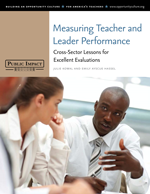 Cross-Sector Lessons for Excellent Evaluations
Cross-Sector Lessons for Excellent Evaluations
Performance measurement systems need to document and recognize differences among educators
A recent national push to use performance evaluations for critical personnel decisions has highlighted the shortcomings of our current systems and increased the urgency to improve them dramatically. This report, written with support from The Joyce Foundation, summarizes best practices and research from other sectors for education leaders who want accurate, reliable, and meaningful information about educators’ performance.
Six Steps For Education Leaders
- Determine the purposes of performance measurement, such as informing professional development, promotions, compensation, retention, and dismissals. Engaging top leadership in conversation about these purposes helps ensure that evaluation systems provide the type and quality of information necessary to guide each decision.
- Choose job objectives that align with the organization’s mission to ensure that performance measures and the measurement process capture the critical outcomes and behaviors needed from each employee to achieve the school’s, district’s, or education provider’s mission.
- Design performance measures, including what individuals in each role are expected to contribute and how they are expected to achieve results. By choosing the right measures, organizations clarify and stimulate staff actions that contribute to success.
- Set performance standards to use as a yardstick for assessing employees’ performance, so that both leaders and staff know what good and great performance looks like.
- Design the performance measurement process by determining who will organize and have input into evaluations, using what process, and how often.
- Use measurement results to take action, including making decisions about professional development; promotions and reach extension; career planning; compensation; retention and dismissals; and future recruiting and hiring.
Many of these lessons echo elements that reformers have called for in education, such as:
- Measuring both the “what” and “how” of educators’ performance. Assessing both student results and educators’ skills and competencies will increase the developmental value of evaluations and lay the groundwork for better-informed decisions about compensation, promotion, reach extension, and dismissal.
- Conquering fears of measuring student learning. District and state leaders must also consider data about teachers’ and leaders’ contributions to student progress. After all, schools are in the business of learning—and students’ academic growth is the primary outcome.
- Using performance measurement results. Improving performance measurement systems will have no effect unless the results are put to use. States, districts, and other providers must commit to act upon real differences in educator effectiveness—by using evaluations as the basis for teachers’ and principals’ ongoing development and pay, decisions about retention and dismissal, and future recruiting and selection.
Great organizations in other sectors have also catapulted past even the boldest calls for reform in education to refine their measurement systems and obtain the most impact, such as by:
- Adopting strategies to protect against leniency and bias. Tactics include rating on a forced distribution, holding managers accountable for the appraisals they conduct, including reviews from multiple perspectives with different weights, and providing training in the performance measurement process.
- Meaningfully assessing team performance. Where individuals’ contributions occur at the team level, great organizations get smart about assessing performance in that context, through peer evaluations and statistical analyses, and by assessing team outcomes alongside individual results.
- Measuring more to measure better. With a simultaneous commitment to use the lessons and measurement tools available today and improve them in the future, we can rapidly advance performance measurement—and more quickly contribute to improved student outcomes.
- Rapidly adjusting measures that do not predict success. Great organizations change their measures, and measurement processes, to continue making progress and to reflect changes in how work is done. Education must do no less.
Leaders of successful organizations in other industries have long recognized that talent—and strategic management of that talent—is one key to success. There is no sector where talent is more important than education. We must carefully consider lessons learned from decades of performance measurement in other sectors, both to inform our current efforts and to spur the next generation of reform.
